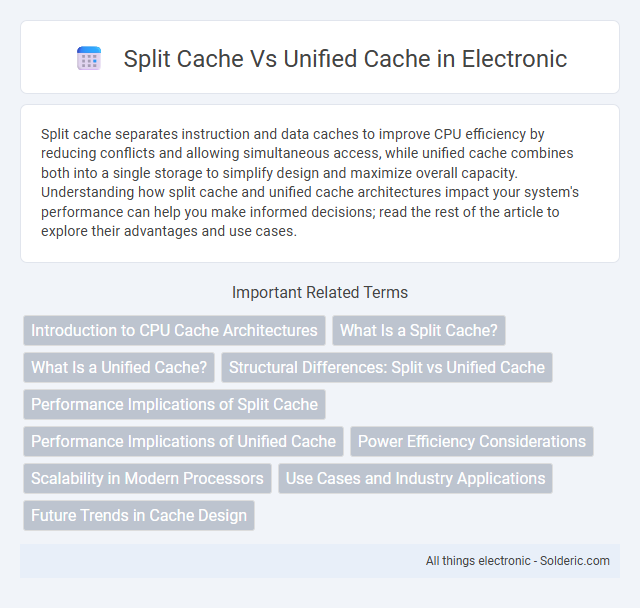Split cache separates instruction and data caches to improve CPU efficiency by reducing conflicts and allowing simultaneous access, while unified cache combines both into a single storage to simplify design and maximize overall capacity. Understanding how split cache and unified cache architectures impact your system's performance can help you make informed decisions; read the rest of the article to explore their advantages and use cases.
Comparison Table
| Feature | Split Cache | Unified Cache |
|---|---|---|
| Cache Structure | Separate caches for instructions and data | Single cache for both instructions and data |
| Performance | Reduces contention, improves parallel access | Flexible allocation, better overall utilization |
| Complexity | More complex design and management | Simpler design, easier to manage |
| Hit Rate | May have lower hit rate due to fixed partitioning | Typically higher hit rate with dynamic allocation |
| Use Cases | Common in RISC architectures (e.g., ARM, MIPS) | Often used in CISC architectures (e.g., x86) |
| Latency | Lower latency due to concurrent access paths | Potentially higher latency during conflict access |
Introduction to CPU Cache Architectures
CPU cache architectures primarily include split cache and unified cache designs, which play critical roles in optimizing processor performance by reducing memory access latency. Split cache architecture divides the cache into separate instruction cache (I-cache) and data cache (D-cache), enhancing parallelism and reducing contention during fetch and execution stages. Unified cache combines both instructions and data into a single cache hierarchy, maximizing cache utilization efficiency and simplifying cache coherence mechanisms in modern multi-core processors.
What Is a Split Cache?
A split cache is a CPU cache architecture that separates the instruction cache (I-cache) and data cache (D-cache) into distinct memory areas to improve processing speed and efficiency. By isolating instructions and data, the split cache reduces contention and allows simultaneous access, minimizing cache misses and latency. This design is commonly used in RISC processors to optimize instruction fetch and execution pipelines.
What Is a Unified Cache?
A unified cache is a single memory storage design that stores both instruction and data caches together, improving cache utilization and reducing latency by allowing dynamic allocation of cache space based on demand. Unlike split caches, which separate instruction and data caches, a unified cache can enhance performance in applications with varying instruction-to-data fetch ratios. Your system benefits from faster access times and better cache efficiency with a unified cache, especially in workloads with unpredictable memory access patterns.
Structural Differences: Split vs Unified Cache
Split cache architecture separates instruction cache (I-cache) and data cache (D-cache) to reduce contention and improve parallelism, enabling simultaneous fetching of instructions and data. Unified cache combines both instructions and data in a single cache, simplifying design but potentially causing conflicts as both compete for the same cache space. The structural distinction directly influences cache hit rates, access latency, and overall processor performance in diverse computing workloads.
Performance Implications of Split Cache
Split cache architecture separates instruction and data caches, reducing contention and improving parallel access efficiency, which enhances overall processor performance in workloads with high instruction and data fetch demands. This segregation minimizes cache misses and latency by allowing simultaneous fetch and load/store operations without interference. However, the effectiveness depends on workload characteristics, as unified caches may perform better in scenarios with unpredictable access patterns due to their flexible resource allocation.
Performance Implications of Unified Cache
Unified cache architecture enhances performance by enabling dynamic allocation of cache resources between instructions and data, reducing cache misses and improving hit rates. This flexibility allows better utilization of the cache, especially in workloads with varying demands on instruction and data access, leading to faster execution and lower latency. Unified caches simplify cache coherence and reduce redundancy, which contributes to more efficient CPU performance compared to split caches.
Power Efficiency Considerations
Split cache architecture separates instruction and data caches, reducing power consumption by allowing selective activation based on workload demands, which can lead to lower energy usage in embedded and mobile processors. Unified cache, while simpler in design, tends to consume more power as it accesses both instructions and data from a single cache, potentially increasing switching activity and power draw. Your choice between split and unified cache should consider the specific power efficiency requirements of your application's performance profile.
Scalability in Modern Processors
Split cache architectures, featuring separate instruction and data caches, enhance scalability in modern processors by allowing parallel access paths, reducing contention and latency. Unified cache designs offer flexibility in allocating cache resources dynamically, improving efficiency under varying workloads but may face bottlenecks as core counts increase. Your choice between split and unified caches impacts scalability by balancing parallelism benefits against resource sharing in multi-core environments.
Use Cases and Industry Applications
Split cache architectures, often employed in microcontrollers and embedded systems, optimize performance by dedicating separate caches for instructions and data, enhancing real-time processing in automotive and IoT applications. Unified cache systems, favored in desktop processors and high-performance computing, provide flexible memory allocation suitable for dynamic workloads like gaming, AI, and data analytics. Industry adoption hinges on workload characteristics, with split caches excelling in latency-sensitive environments and unified caches maximizing throughput in versatile computing contexts.
Future Trends in Cache Design
Future trends in cache design emphasize increased integration and adaptability, with hybrid cache architectures merging split cache benefits--such as separate instruction and data caches--with unified cache flexibility to optimize performance and power efficiency. Emerging technologies like machine learning algorithms are used to dynamically manage cache allocation, predicting workload behavior to enhance hit rates and reduce latency. Your system can benefit from these innovations by leveraging caches that intelligently balance resource distribution for evolving application demands.
split cache vs unified cache Infographic

 solderic.com
solderic.com